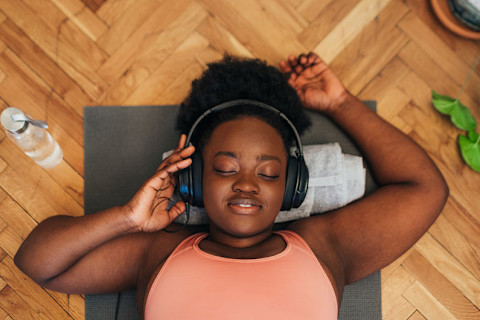How To Do The Lion's Breath For Enhanced Energy & Communication
Yoga involves so much more than just the physical poses, and pranayama (yogic breathing practices) is another facet of a complete yoga practice. Just as each physical pose (or "asana") has different benefits, the different breathing techniques you'll come across have their own benefits, too.
Lion's breath, or simhasana pranayama in Sanskrit, is one powerful breath that can help you clear your throat chakra, become more energized, and more. Here's what lion's breath is all about, how to do it, and tips to keep in mind when you do.
What is lion's breath?
Lion's breath is a form of pranayama—a breathing exercise from the yogic tradition, breathing practitioner and author of The Oxygen Advantage Patrick McKeown, M.A., explains to mbg. "It involves forceful exhalations through the mouth with the tongue extended and stretched down toward the chin," he adds.
This technique gets its name because as you sit for lion's breath, your posture resembles that of a sitting lion. (In Sanskrit, simha means "lion.")
In the yogic tradition, lion's breath is thought to help people balance or clear their throat chakras and strengthen their lungs. It's also an energizing breath and is often done before a physical yoga practice.
How to do lion's breath:
Finding the right pose.
Before getting started, you'll want to decide on two things: how you're going to sit, and where you're going to focus your gaze (or drishti).
Traditionally, lion's breath is done in lion's pose: From a kneeling position, you cross your right ankle on top of the left, and sit back with your right heel on the perineum. That said, lion's breath can also be performed cross-legged, in half-lotus, in thunderbolt, in hero's pose, or even in a chair.
From there, you can choose to fix your gaze toward your third eye (between your eyebrows), the tip of your nose, or up toward the ceiling.
Method:
- Get into your seated position of choice.
- Place your hands on your knees or on the floor. If on the floor, point the fingertips in toward yourself. Spread the fingertips wide, like a lion's claws.
- Lean the upper body forward slightly.
- Inhale through your nose with your mouth closed.
- Open your mouth wide and stick out your tongue as much as you can, curling it down toward your chin.
- Exhale forcefully with a "ha" sound, feeling the breath come from deep within and passing across your entire tongue. Keep the tongue out for the entire exhale and don't be afraid to get loud.
- Relax your face and take a few normal breaths before doing another lion's breath.
- Repeat until you've completed four to six lion's breaths. If you're sitting in lion's pose, switch the crossing of your feet halfway through.
- Once your repetitions are complete, breathe deeply in and out through the nose for at least three minutes before moving on.
Benefits of lion's breath:
It can help clear emotions.
According to McKeown, lion's breath is said to clear the throat and engage the lungs. He's seen it be particularly popular for people with a speech impediment as "it also helps release emotions and work through self-consciousness," he says.
It stretches the face and neck.
This technique also provides a nice stretch for the face and neck, making it great for relieving tension in both areas.
It clears the throat chakra.
Lion's breath is closely associated with the fifth or throat chakra, which revolves around themes of communication, using your voice, openness, and expression.
On top of these benefits, pranayama, in general, has a wide variety of benefits and applications, with research showing it can help regulate the nervous system1, ease anxiety2, and improve overall attention and focus3.
Tips and tricks to try:
- Give it your all: This is an empowering and energizing technique but only when you put your heart into it. Try not to worry about what you look like, and just focus on exhaling all that air out, imagining you're ridding yourself of any stagnant or negative energy.
- Engage the three bandhas: If you're familiar with the bandhas, or the internal "locks" of yoga, you can also work with them during lion's breath. All three bandhas can be engaged during this breath, but this is best left to those with a good amount of asana and pranayama experience.
- Split up the practice with normal breathing: Don't skip out on breathing normally with intention when you're done with your repetitions of lion's breath, as McKeown notes light breathing will help normalize blood chemistry and balance the nervous system.
Risks and side effects.
McKeown does not recommend lion's breath to people who are brand new to breathwork or have pre-existing respiratory problems, as the forceful exhalations can risk trauma to the airways. When in doubt, ask your medical practitioner if the breath is safe for you to try.
Sitting in lion's pose also won't be comfortable for those with knee injuries. If that's you, you can opt to sit in a chair or another comfortable position instead.
The bottom line.
There are so many breathing techniques out there, from nadi shodhana to tummo breathing. Understanding what their benefits are can help you choose the right one for you on any given day. The time you need a confidence boost, want to clear your throat chakra, or simply give your face and neck a nice stretch, give lion's breath a try.

